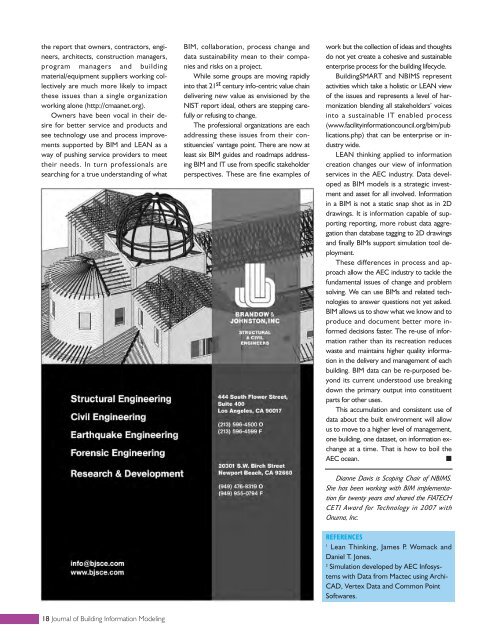Journal of Building Information Modeling (JBIM) - Fall 2007
Journal of Building Information Modeling (JBIM) - Fall 2007
Journal of Building Information Modeling (JBIM) - Fall 2007
Create successful ePaper yourself
Turn your PDF publications into a flip-book with our unique Google optimized e-Paper software.
the report that owners, contractors, engineers,<br />
architects, construction managers,<br />
program managers and building<br />
material/equipment suppliers working collectively<br />
are much more likely to impact<br />
these issues than a single organization<br />
working alone (http://cmaanet.org).<br />
Owners have been vocal in their desire<br />
for better service and products and<br />
see technology use and process improvements<br />
supported by BIM and LEAN as a<br />
way <strong>of</strong> pushing service providers to meet<br />
their needs. In turn pr<strong>of</strong>essionals are<br />
searching for a true understanding <strong>of</strong> what<br />
18 <strong>Journal</strong> <strong>of</strong> <strong>Building</strong> <strong>Information</strong> <strong>Modeling</strong><br />
BIM, collaboration, process change and<br />
data sustainability mean to their companies<br />
and risks on a project.<br />
While some groups are moving rapidly<br />
into that 21 st century info-centric value chain<br />
delivering new value as envisioned by the<br />
NIST report ideal, others are stepping carefully<br />
or refusing to change.<br />
The pr<strong>of</strong>essional organizations are each<br />
addressing these issues from their constituencies’<br />
vantage point. There are now at<br />
least six BIM guides and roadmaps addressing<br />
BIM and IT use from specific stakeholder<br />
perspectives. These are fine examples <strong>of</strong><br />
work but the collection <strong>of</strong> ideas and thoughts<br />
do not yet create a cohesive and sustainable<br />
enterprise process for the building lifecycle.<br />
<strong>Building</strong>SMART and NBIMS represent<br />
activities which take a holistic or LEAN view<br />
<strong>of</strong> the issues and represents a level <strong>of</strong> harmonization<br />
blending all stakeholders’ voices<br />
into a sustainable IT enabled process<br />
(www.facilityinformationcouncil.org/bim/pub<br />
lications.php) that can be enterprise or industry<br />
wide.<br />
LEAN thinking applied to information<br />
creation changes our view <strong>of</strong> information<br />
services in the AEC industry. Data developed<br />
as BIM models is a strategic investment<br />
and asset for all involved. <strong>Information</strong><br />
in a BIM is not a static snap shot as in 2D<br />
drawings. It is information capable <strong>of</strong> supporting<br />
reporting, more robust data aggregation<br />
than database tagging to 2D drawings<br />
and finally BIMs support simulation tool deployment.<br />
These differences in process and approach<br />
allow the AEC industry to tackle the<br />
fundamental issues <strong>of</strong> change and problem<br />
solving. We can use BIMs and related technologies<br />
to answer questions not yet asked.<br />
BIM allows us to show what we know and to<br />
produce and document better more informed<br />
decisions faster. The re-use <strong>of</strong> information<br />
rather than its recreation reduces<br />
waste and maintains higher quality information<br />
in the delivery and management <strong>of</strong> each<br />
building. BIM data can be re-purposed beyond<br />
its current understood use breaking<br />
down the primary output into constituent<br />
parts for other uses.<br />
This accumulation and consistent use <strong>of</strong><br />
data about the built environment will allow<br />
us to move to a higher level <strong>of</strong> management,<br />
one building, one dataset, on information exchange<br />
at a time. That is how to boil the<br />
AEC ocean. ■<br />
Dianne Davis is Scoping Chair <strong>of</strong> NBIMS.<br />
She has been working with BIM implementation<br />
for twenty years and shared the FIATECH<br />
CETI Award for Technology in <strong>2007</strong> with<br />
Onuma, Inc.<br />
REFERENCES<br />
1 Lean Thinking, James P. Womack and<br />
Daniel T. Jones.<br />
2 Simulation developed by AEC Infosystems<br />
with Data from Mactec using Archi-<br />
CAD, Vertex Data and Common Point<br />
S<strong>of</strong>twares.

















